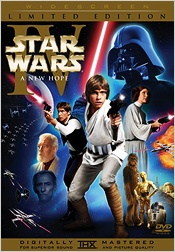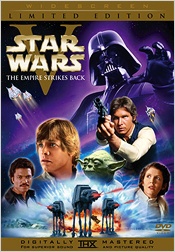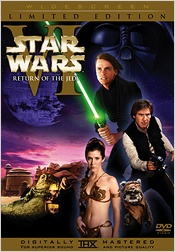


Anyone who is desperately craving copies of all of the Star Wars movies on DVD should look over the options available and think about what they want, because at this point there are good commercial copies of all six movies readily available. The discs that we have finally received from Fox prove that LucasFilm does at least provide high quality audio and video as well as some good extras, when they finally get around to releasing a title on DVD. The original trilogy's 2004 DVD release, reviewed below, makes any SE bootleg irrelevent, just as the Phantom Menace, Attack of the Clones, and Revenge of the Sith discs did in 2001, 2002, and 2005. I've retained reviews of the Phantom Menace and SE trilogy bootlegs just for the sake of amusement at this point, even though I don't recommend wasting your time on any prequel or Special Edition bootlegs. Bootleg activity continued beyond 2004, however, solely because of the changes made by Lucas to the original trilogy for the 1997 Special Edition re-release and the subsequent changes for the 2004 DVD's. Fans' desire to have a digital archive of the original theatrical versions of the trilogy led to a strong interest in bootlegs based on the 1993 or 1995 LaserDisc releases. By the time the Limited Edition discs arrived, those bootlegs had gotten surprisingly sophisticated, so I've left my reviews of those discs in place along with the reviews of the official releases. Links to each page are available below and are reproduced at the top of each review.
If you feel a touch of deja-vu when considering DVD's of the Star Wars Trilogy, don't feel bad. A couple years ago, I wrote a review of the Trilogy four-disc boxed set. That set marked the first official release of the trilogy on DVD, even though the format was then six and a half years old, and all indications are that Lucas would have held off for another year or two beyond that if not for the rampant bootlegging that used LaserDisc releases from the 1990's as source material. A series of petitions probably helped, as did the sales numbers for the 2003 box set of Indiana Jones movies, but the bootleg industry surrounding the trilogy was probably the largest single factor in bringing about the trilogy's release on DVD. As happy as fans were to get the movies on disc, there was a problem: the discs contained only the edited "Special Edition" versions of the films created in 1997 along with a few even newer edits created in 2004. The original theatrical cuts (including effects shots that were groundbreaking in 1977 and a Han Solo who didn't have to wait for a bounty hunter to shoot at him before pulling the trigger) were dismissed by Lucas as rough drafts that he'd put behind him. This decision left one sector of the old Star Wars bootleg DVD market secure: the original theatrical cut crowd. Resourceful fans turned to LaserDiscs (primarily the 1993 Definitive Edition discs) and began working to craft the best possible discs they could. Some people converted the 1993 stereo soundtracks to Dolby Digital 5.1, while others preserved the original uncompressed PCM. Eventually, bootleggers were able to go so far as to craft anamorphic transfers and to use dual-layer discs. Since Lucas seemed determined to stick to his guns and leave the original versions on the cutting room floor, these DVD-R's were all that there was.
That brings us to the spring of 2006, when we started hearing some curious rumors online. Lucas had plans to release a special "limited edition" set of discs of the trilogy that would have the original edits of the films. It became official in May 2006, but it only took a couple weeks for fans to find out that there was a catch. Or two, or three. First, the movies were being released individually as two-discs sets, with each set containing the "Special Edition" movie disc previously released in the 2004 boxed set along with a "bonus" disc containing the original version. That meant fans who already had the boxed set would have to buy the SE discs a second time. The other two catches were even more egregious: not only was the audio just a Dolby Digital 2.0 copy of the stereo tracks from the 1993 Definitive Edition, but the video was a non-anamorphic transfer also taken from those 1993 LaserDiscs. I doubt many people would have complained if Lucasfilm had elected to skip the massive digital clean-up restoration done by Lowry Digital for the 2004 discs, but to not even strike a modern anamorphic transfer was considered an outrage by many. After all, it's been years since studios could reasonably expect to release widescreen movies on DVD without anamorphic transfers, so seeing Lucas (the man who helped create THX to make sure movies were presented as faithfully as possible both in theaters and in homes) try it was pretty appalling. Penny Arcade offered one of the more amusing theories as to why a new transfer wasn't produced (in response to the claim by Lucasfilm that a new transfer wasn't possible because film elements no longer existed). In the end, discs that could have been hugely important to fans ended up arriving on shelves with very little fanfare because of widespread disappointment in the marginal effort behind them.
I'm not going to take any time here to discuss the SE discs included in these three releases, since I've already reviewed the exact same discs in my Star Wars Trilogy review from two years ago. The cases themselves do use the same gold font colors as the widescreen prequel discs, so they blend in nicely with the other spines on your shelf. The cover art consists of photo montages modeled after old movie posters, but the end result is not really any more impressive than the photo montage covers for the other Star Wars discs. It's a consistent pattern, but in each case there's a tendency to wonder what could have been done by someone like Ralph McQuarrie or Doug Chiang or any of the other talented artists responsible for Star Wars' excellent concept art. The real focus of this review is going to be on the three bonus discs: the original theatrical versions of all three movies.
After a lengthy delay, I finally made some time to poke around in the Limited Edition discs. I skipped around in three versions of A New Hope: the 2004 Special Edition DVD, the 2006 Limited Edition "bonus disc" DVD (original theatrical cut), and the recent anamorphic bootleg of the 1993 Definitive Edition LD (the Cowclops/TR47 bootleg). Not surprisingly, the 2004 SE has the best video transfer, followed by the 2006 LE (definitely softer in places than the 2004 discs, presumably due both to the Lowry digital restoration of the 2004 SE's and the fact that the 2006 LE isn't anamorphic), and lastly the Cowclops/TR47 DE bootleg (which is marginally to noticeably softer than the 2006 LE even though it has the benefit of an anamorphic transfer). The 2006 Limited Edition DVD's transfers are definitely not as crisp as the 2004 Special Edition DVD's transfers, but they are still sharper and a touch clearer than the best bootlegs I've seen. There was reportedly some digital restoration done during the creation of the DVD's from the old LaserDisc transfers, but I suspect that much of the credit for the 2006 LE's better video transfer when compared to the best Definitive Edition bootlegs comes from the access to the actual original master (rather than a LaserDisc made from that master) and the more powerful commercial software available for doing the MPEG video compression. The added bit budget of a dual-layer disc may have helped as well, although as the dual-layer bootlegs proved that extra space is not in and of itself a magic bullet.
Here's an interesting question: why the hell does a non-anamorphic widescreen transfer end up with an anamorphic widescreen menu? Are they just trying to highlight exactly what we're missing out on because they elected to recycle a thirteen year old LaserDisc transfer? That just struck me as odd.
The audio here is plain old Dolby Digital 2.0, the exact same audio track included on the 1993 Definitive Edition LaserDiscs converted to Dolby Digital. It includes the same Pro Logic matrix cues that the 1993 LaserDiscs had, so today's Pro Logic II decoders will have an easy time with it, but I really would have liked to have seen an uncompressed PCM stereo audio track included as the primary audio track. Since we're being limited to two channels anyway and these discs are essentially a sort of "archive" copy of the versions that Lucas has now deemed to be simply rough drafts, it would have been a nice touch. It would also have been nice to see a Dolby Digital 5.1 track derived from the old Pro Logic mix as a secondary option for folks without Pro Logic II decoders.
The effects shots on the Limited Edition discs are exactly as they were in 1993, with no refinements (so things like the lightsabers in the duel between Vader and Obi-Wan are still occasionally white). The result isn't as seamless as Lucas would like us to see, but it is exactly what was achieved back in 1977 (or 1980, or 1983) and it's an important piece of cinematic history. And the scene with Han and Greedo in the cantina flows much more smoothly without the spliced in scene of Greedo taking a shot before his death.
Eight or nine years ago, studios routinely released widescreen DVD's with non-anamorphic transfers. Early adopters of the DVD format didn't like it, but their objections took several years to really sink in. Fortuntely, by the time that DVD releases really took off and HDTV's made 16:9 TV's a practical reality for many, the studios had acknowledged consumer priorities and begun making anamorphic transfers of widescreen movies the standard that it should have been from the format's launch in March 1997. The "bonus discs" of the 2006 Limited Edition Star Wars DVD's are good news in that they finally preserve the original theatrical versions of the Star Wars Trilogy on the DVD format. The "bonus discs" are bad news at the same time though, and for several reasons. The video is non-anamorphic widescreen – something that should not appear on any commercial DVD release today. To make matters worse, consumers have to buy the 2004 Special Edition DVD's of the movies to get these "bonus discs" – even though most fans already bought those very same discs two years ago. These discs are the best that anyone could probably get from the 1993 Definitive Edition transfers – it's just a shame that they weren't packaged on their own, didn't have anamorphic transfers, and didn't include lossless PCM audio.
[an error occurred while processing this directive] visits since September 15, 2006